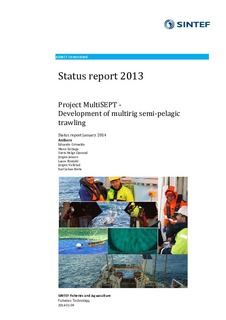| dc.contributor.author | Grimaldo, Eduardo | |
| dc.contributor.author | Sistiaga, Manu Berrondo | |
| dc.contributor.author | Gjøsund, Svein Helge | |
| dc.contributor.author | Jensen, Jørgen Haavind | |
| dc.contributor.author | Rindahl, Lasse | |
| dc.contributor.author | Vollstad, Jørgen | |
| dc.contributor.author | Reite, Karl Johan | |
| dc.date.accessioned | 2017-10-03T16:28:33Z | |
| dc.date.available | 2017-10-03T16:28:33Z | |
| dc.date.created | 2017-10-02T10:41:38Z | |
| dc.date.issued | 2014-01-09 | |
| dc.identifier.isbn | 978-82-14-05653-2 | |
| dc.identifier.uri | http://hdl.handle.net/11250/2458173 | |
| dc.description.abstract | In 2013, new knowledge on semi-pelagic trawling has been created in MultiSEPT project. The achievements in the project have been possible because of extensive cooperation between the scientific and industrial partners. This report briefly describes the activities carried out in the MultiSEPT project in 2013. Full scale tests of the semi circular spreading gear (SCSG) showed that this ground gear was easy to rig and operate, its geometry was stable during towing and it had good bottom contact. The spreading (distance between wing-ends) was approximately 7 % higher with the SCSG than with the rockhopper gear for the same gear and door spreading. The SCSG had good bottom contact and passed bottom obstacles (e.g.stones) easily. The size distribution of fish caught with the SCSG was very similar to that caught with the rockhopper. However, the number of hauls performed with the SCSG and with the rockhopper was too small to draw a clear conclusion on catch efficiency. The SCSG is a gear that is easy to rig and handle on deck, it does not require accurate adjustments, it has few control points and low weight, and the results indicate that its performance at sea is at least comparable to the rockhopper gear for given bottom conditions. Further development of the SCSG should emphasise on improving the construction materials used today in oder to reduce the wearing and increase its lifetime. Two full scale tests were carried out in spring and autum 2013 to assess the effect of sweep length on herding of fish during semi-pelagic trawling for cod and haddock. The results showed that sweep length can have a significant effect on the catches. Fixing the 450-kg chain weights right in front of the ground gear captured in up to 50% less cod and up to 60% haddock (of all sizes) than when the chain weights were fixed 45 m in front of the ground gear. These results demonstrate that at least under the conditions encountered in these trials, the sweeps have a major role on the fish herding process of the gear. The state estimator model (the core of of the Roll Royce Marine's e-Trawling system) was compared with data from small scale tests in SINTEF's test tank in Hirtshals, Denmark, carried out in July 2013. The results showed that the model apparently works well. The state estimator model is currently being validated against acoustic sensor data from full scale trials with semi-pelagic trawling carried out in November 2013. A concept for remote control of existing trawl doors, which is based on manipulating the moment Balance of the trawl doors, has been designed by SINTEF. This is achieved using control lines between points on the trawl door and external lines (warps or bridles). By tensioning such lines, the orientation of the trawl door is controlled, which again is used to control the hydrodynamic forces created by the trawl door. The energy consumption of this concept is greatly reduced by changing the rigging of the trawl door to reduce its stability. A pair of 0.6 m2 Injector XF9 semi-pelagic doors are currently being instrumeted with actuator and will be tested in Hirtshals' flume tank in early 2014. Semi-pelagic shrimp trawling showed approx. 6-8 % lower fuel consumption than bottom shrimp trawling.The 2.5 m2 semi-pelagic doors tested during our trials were overdimensioned for the coastal trawler "Gullholmen", and they had to be set at the lowest angle of attack to reduce spreading force and match that of the bottom trawl doors normally used by the vessel. A set of smaller doors ( approx. 2 m2) would had been a better choice to achieve the spreading force necessary for a 1500 # shrimp trawl. This would have reduced the fuel consumption even more. Shrimp catches were too low (15 – 45 kg/hour) and very variable from haul to haul to draw any conclusion on the fishing efficiency of the gear with the different sets of doors. Further experiments with coastal shrimp trawlers are planned for winter 2014. | nb_NO |
| dc.description.sponsorship | The Research Council of Norway The Norwegian Seafood Research Fund (FHF) Rolls-Royce Marine AS Mørenot AS | nb_NO |
| dc.language.iso | eng | nb_NO |
| dc.publisher | SINTEF Fiskeri og havbruk | nb_NO |
| dc.relation.ispartofseries | SINTEF Fiskeri og havbruk reports;A25817 | |
| dc.rights | Attribution-NonCommercial-NoDerivatives 4.0 Internasjonal | * |
| dc.rights.uri | http://creativecommons.org/licenses/by-nc-nd/4.0/deed.no | * |
| dc.subject | Fishing gear technology | nb_NO |
| dc.subject | Trawl | nb_NO |
| dc.subject | Bottom trawl | nb_NO |
| dc.subject | Semi-pelagic trawl | nb_NO |
| dc.subject | Ground gear | nb_NO |
| dc.subject | Herding | nb_NO |
| dc.subject | Tråldør | nb_NO |
| dc.title | Project MultiSEPT - Development of multirig semi-pelagic trawling | nb_NO |
| dc.type | Research report | nb_NO |
| dc.description.version | publishedVersion | nb_NO |
| dc.rights.holder | SINTEF Ocean | nb_NO |
| dc.source.pagenumber | 20 | nb_NO |
| dc.identifier.cristin | 1501292 | |
| cristin.unitcode | 7566,2,0,0 | |
| cristin.unitname | Fiskeriteknologi | |
| cristin.ispublished | true | |
| cristin.fulltext | original | |

